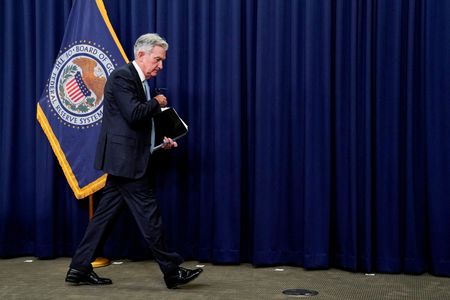(This Dec. 16 story has been corrected to change the spelling of name from Owen to Owens in the 20th paragraph)
By Howard Schneider
WASHINGTON (Reuters) – Like many economists, Vanguard’s Joe Davis thinks the United States will experience a recession in 2023, and like many of his colleagues he does not think it will be a serious one.
He has tentatively dubbed it the “Zoom recession,” in effect a readjustment from the excesses of the pandemic – with tech and a handful of industries in the crosshairs as people reset how they use their time and money, but with many industries skirting trouble.
“It is getting back to normal,” he said.
The U.S. Federal Reserve in new economic projections this week did not explicitly jump into the recession camp, and Fed Chair Jerome Powell said he feels the country can maintain “modest” growth and sees only a “modest” increase in unemployment even as the Fed deliberately tries to slow things down to cool inflation.
“I don’t think it would qualify as a recession,” Powell said of the growth rate penciled in by policymakers.
Still, the Fed’s outlook is mighty weak, a half percent growth next year and a rise in unemployment that would be the equivalent of about 1.6 million more people out of work by this time next year – outcomes that look recessionary.
It may turn out different this time, but only if the Fed is able to buck history.
A FLASHBACK TO….?
Recessions in the United States have come in many flavors – deep or shallow, short or long. The last two have spanned extremes.
The pandemic caused an acute shock that pushed the unemployment rate to nearly 15% and saw the economy contract from April through June of 2020 at a Depression-like annual rate of 30%. But GDP grew 35% in the following quarter, within two years the unemployment rate had fully recovered, and the recession was judged to have lasted two months.
By contrast the downturn caused by a collapsing housing market and a broader financial crisis lasted a year and a half, from December 2007 to June 2009, a span during which GDP shrank during five of six quarters. Payroll employment continued dropping for eight months after the recession ended and took six and a half years to regain its prior peak.
If a recession does develop next year, no one expects it to look like either of those.
Households and firms are far less leveraged than they were back in 2007, with modest debt service payments in relation to income, and a financial sector that – due to post financial crisis regulations – is better capitalized. All of those factors lower the risk of a financial crisis, and the deeper sort of recession associated with it.
Graphic: U.S. household warchests, https://www.reuters.com/graphics/USA-FED/RECESSION/gkplwwlzmvb/chart.png
A closer analogy, Davis suggests, may be the period from March 2001 to November 2001. Those months were declared a recession by the National Bureau of Economic Research’s Business Cycle Dating Committee, and add some context to the Fed’s latest projections.
Gross domestic product did shrink in the first and third quarters of 2001, but grew in the second and fourth, and for the year overall expanded by 1%.
That’s twice the annual growth the Fed says the United States will have experienced in 2022, and what it foresees through 2023.
The rise in the unemployment rate then was more than the Fed currently anticipates for next year. From 3.9% in December 2000 the jobless rate rose to 5.7% a year later, and the estimated number of unemployed rose by more than 2.5 million in a much smaller labor force.
The Fed sees unemployment rising from 3.7% now to 4.6% in 2023 and remaining almost unchanged for two years after that.
In contrast to the “jobless recovery” that bedeviled the United States after the 2007 downturn, the projections that Powell and his colleagues are sketching might evolve into a “job-ful recession,” a downturn that passes without any deep scar to the labor market.
But on its own the rise in the unemployment rate seen by the Fed would be consistent with a recession, and one feature of the U.S. economy is that once the unemployment rate rises by half a percentage point it usually rises a lot more from there.
“There is no such thing as a ‘light’ recession,” said Lindsay Owens, executive director of the Groundwork Collaborative, a group that works on issues around economic equality and jobs, and argues that the Fed is putting workers too much at risk in its inflation fight. “If a million more people are unemployed, they will be disproportionately black, brown, older. The consequences will be stark even if Wall Street comes out the other side.”
Graphic: U.S. unemployment rate: Higher means higher, https://www.reuters.com/graphics/USA-FED/JOBS/lgvdwdwoopo/chart.png
KEY INDICATORS ARE MIXED
Though the focus is often on GDP growth, the macroeconomists on the NBER committee look at the factors that ultimately comprise output, not the GDP number itself.
Among some of those central indicators, the economy still looks like it has momentum, even if there are some signs of weakness.
On the plus side is jobs. There has never been a recession declared without an outright decline in employment. So far that keeps growing.
Graphic: Job loss and recession, https://www.reuters.com/graphics/USA-ECONOMY/UNEMPLOYMENT/gdvzqqmgdpw/chart.png
Personal income less government transfer programs is another measure the committee watches, since consumer spending accounts for so much of U.S. economic activity, and declines in household earnings can drive it lower. Even adjusted for inflation it has so far remained steady.
Graphic: Recession and personal income, https://www.reuters.com/graphics/USA-ECONOMY/RECESSION/mypmnrerbvr/chart.png
Industrial production is another metric that dependably turns lower ahead of recession, and is one of the data points that does appear to have peaked – marking the sort of moment that may register with the NBER if it continues lower.
Graphic: U.S. industrial production, https://www.reuters.com/graphics/USA-FED/RECESSION/gkvlwwlempb/chart.png
(Reporting by Howard Schneider; Editing by Dan Burns and Andrea Ricci)

